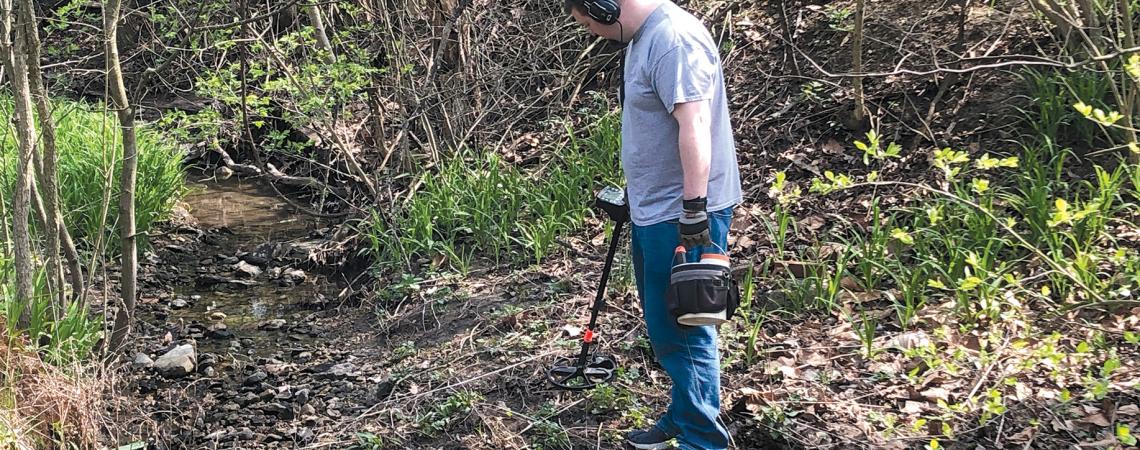We all know that Ohio is full of treasures. From Cincinnati chili to Cedar Point to the hollows of Hocking Hills, the gems gleam. Legends abound, however, of treasure in the more traditional sense — buried or stashed around the Ohio countryside.
From legends of James Dillinger stashing away money to Civil War gold, Ohio is crawling with tales of buried treasure. After sifting through scores of Ohio tales, we found five we think are the most compelling.
Jared Shank, a member of the Dayton Diggers, still ventures out occasionally to check out a new tip on the location of the lost Shawnee silver.
Stark treasure
It was 1755, and the French had been trying desperately to repel attacks by the British on Fort Duquesne, France’s outpost in Pittsburgh. Fearing the fort’s imminent fall (it actually held out until 1758), some French soldiers started to evacuate valuables from Fort Duquesne — including a hoard of gold and silver used for military payroll.
The British pursued, and about halfway to Fort Detroit, with the Redcoats gaining on them, the French reportedly buried everything right there on the spot — around the present-day site of Minerva, in Stark County — with a plan to return later to retrieve the riches. Unfortunately, the terrain makes their directions difficult to follow and, despite numerous attempts, no treasure has ever been found.
Roger Bartley, a Minerva historian who has sought the treasure, thinks it’s still out there somewhere. “Treasure hunters come through a couple of times a year,” he says. “They all have their own theories.”
Shawnee silver
According to Shawnee and frontiersmen lore, there’s a stash of priceless silver somewhere near the Little Miami River in Greene County. Or it could be farther north. Or east. That’s the problem: The history of the silver stash is a little hazy.
While there are variations on the tale, Ohio resident and treasure hunter Jared Shank, a member of the Dayton Diggers treasure-hunting club, says that when the Shawnee were preparing to flee after the Battle of Pickaway near present-day Springfield, they gathered all their silver — they used it in trading, and some estimates say they had more than a ton — and buried it near the Little Miami River to keep it out of the hands of Gen. George Rogers Clark, who was in pursuit. “The first portion they buried in a small pit; they just threw everything into a hole, covered it with brush, and burned it,” he says. “Warriors buried the other part of it near the river.”
Shank says as time has passed, many people have speculated about where all the silver is buried, and the Shawnee, who no longer have a presence in Ohio, have expressed interest in it if it’s ever found.
The Bridge family pot of gold
In 1995, Popular Mechanics caused a stir in Preble County by including a well-known local treasure tale in a list of Top 5 stories of hidden riches. As legend has it, sometime in the 1790s, the Bridge family buried an iron cooking pot filled with at least $100,000 in gold coins on their farm southwest of Eaton. Local historian Stephen Pope told the Dayton Daily News in 1995 that the story of the hidden treasure crops up every 15 years or so, but the treasure remains elusive.
Gallia County river treasure
The pre-Civil War Ohio River was often lawless, yet laden with valuable commerce, which made the rural stretches in southeast Ohio, with its hidden coves and bluffs, irresistible to pirates who are rumored to have stashed treasures in caches along the river. They are also known to have scuttled a riverboat or two. Treasure hunters to this day report finding gold and silver coins washing up near the town of Cheshire from a sunken riverboat, but the source has never been located.
Dillinger’s money
Outlaw James Dillinger and his gang crisscrossed Ohio in the 1930s, robbing banks and generally sowing terror. One of Dillinger’s associates, James Pierpont, used his family farm outside of Leipsic as a base from which to launch dozens of bank robberies across northwest Ohio, and the gang used the farm as a stash house. There’s also rumored to be $825,000 of Dillinger money buried on a farm near Jackson, where a former associate lived.
If you dig
Searching for treasure with a metal detector isn’t as easy as just powering up the device and digging; there’s a lot to consider:
- Many park systems — like Montgomery’s Five Rivers MetroParks — don’t allow metal detectors in parks. Others, such as Cuyahoga County’s park system, require a permit. Franklin County MetroParks does allow metal-detecting. Bottom line: check the rules.
- If you go on private land, get permission from the landowner or else you are trespassing.
- Theft of artifacts from private property and transporting them across state lines may also be a violation of the Archeological Resources Protection Act, a federal law.
- Watch out for utilities. PUCO has a pretty robust enforcement, so be alert for buried pipes and utility lines.










